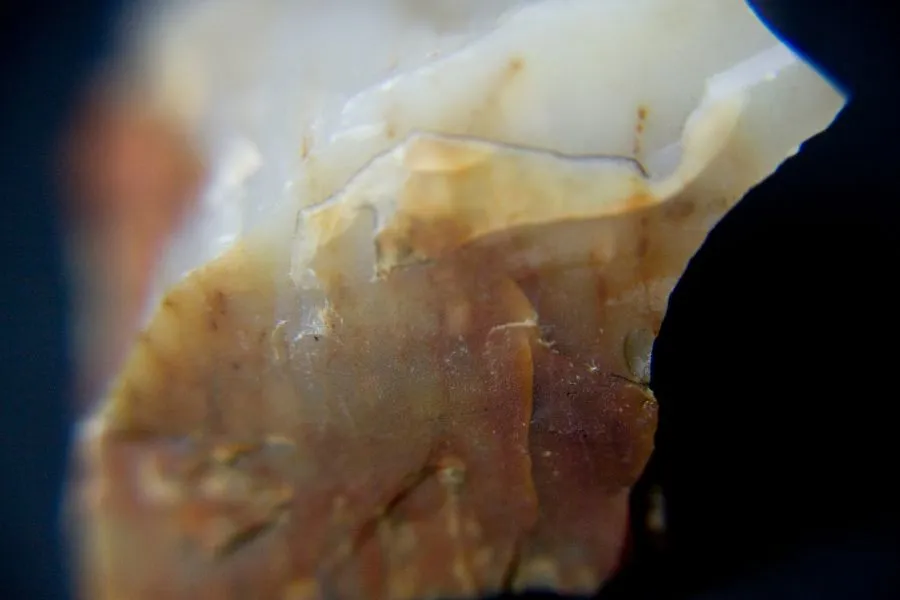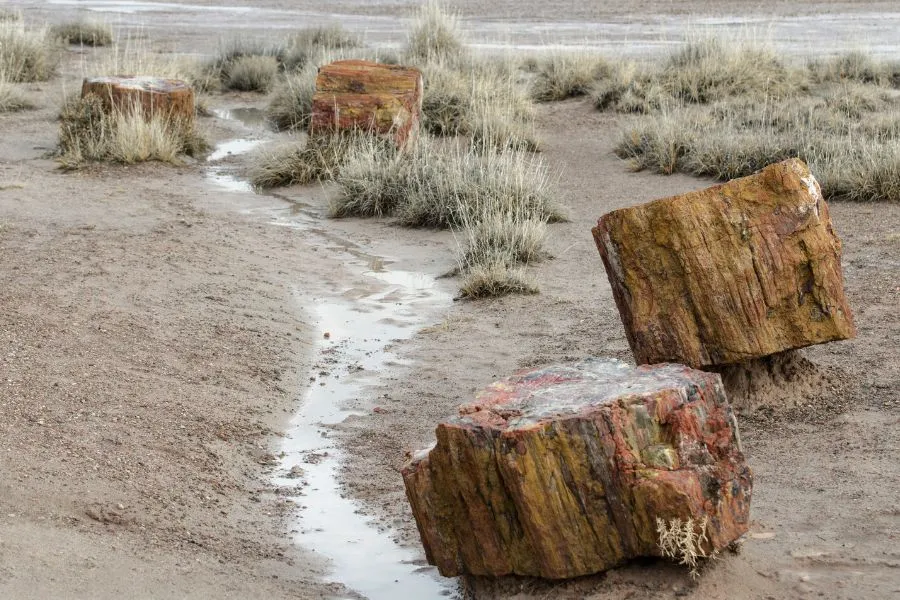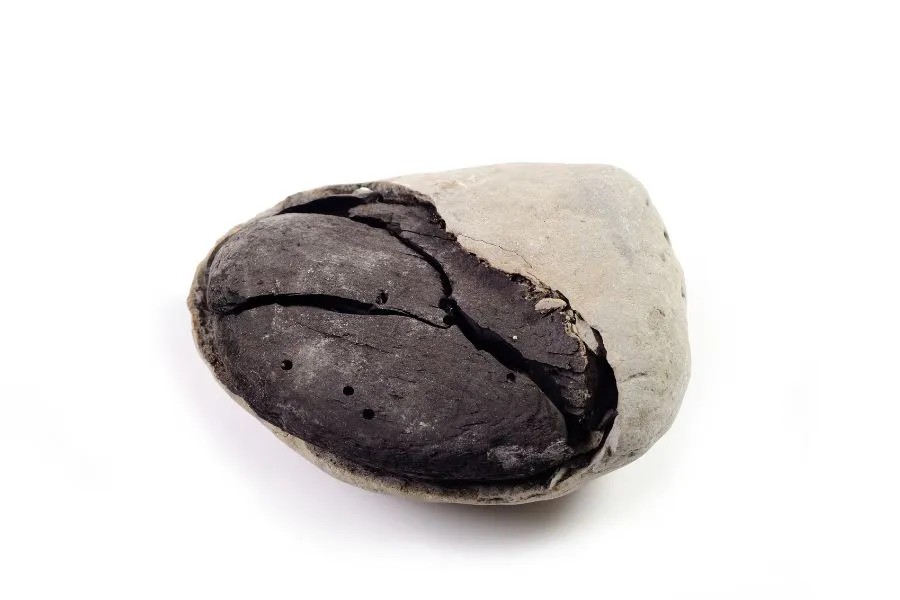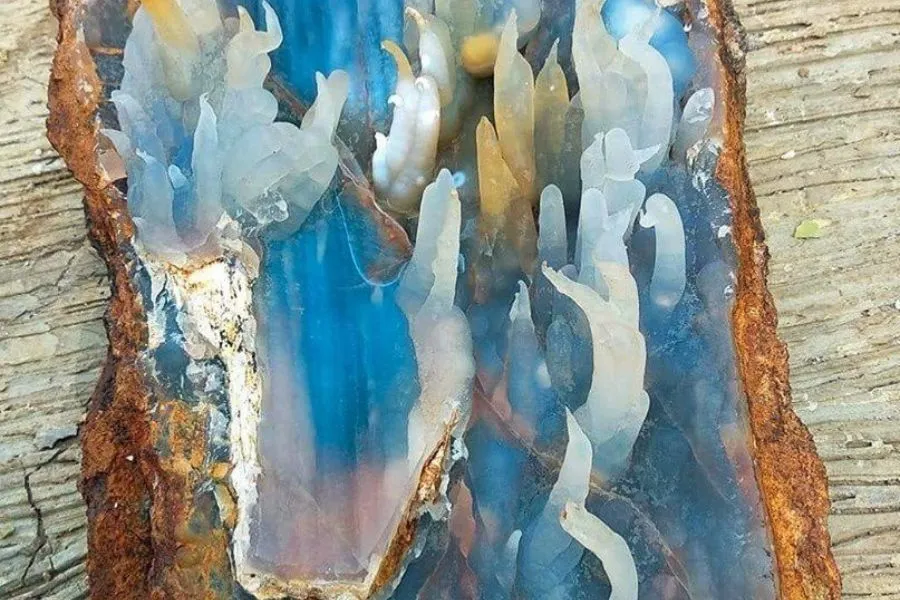Petrified wood is a type of fossil that forms when wood is buried and preserved over time. The process of petrification occurs when the organic materials in wood are replaced by minerals, usually silica, through a process called permineralization. It takes place over millions of years and requires specific conditions, such as the presence of oxygen-free water and certain minerals, to occur.
As the minerals replace the organic matter in the wood, the structure and appearance of the wood is preserved, creating a natural stone that looks and feels like wood. Petrified wood can range in color from shades of brown and tan to shades of red, yellow, and even blue, depending on the minerals that were present during the petrification process.

Petrified wood is a unique and fascinating example of the natural world’s ability to transform and preserve the organic matter that it contains. It is often used in jewelry and home decor, and is valued as a collectible and decorative item. It is also an important source of information for scientists and geologists, who study the process of petrification and use petrified wood to learn about ancient environments and the evolution of plant life.
What is the process of fossilization like?
Fossilization is the process of preserving the remains or traces of organisms that lived in the past. Fossils can take many different forms, including bones, shells, footprints, and even pollen. The process of fossilization occurs when the remains of an organism are protected from decay, usually by being buried in sediment or encased in natural substances like amber.
There are several different ways that fossilization can occur. One common way is through permineralization, in which minerals in the surrounding environment replace the organic matter in the remains, creating a fossil. This is the process that leads to the creation of petrified wood. Another way is through molds and casts, in which the remains of an organism create a hollow space in the sediment, and the sediment hardens and preserves the shape of the remains. Another way is through carbonization, in which the organic matter is preserved through the process of decomposition, leaving behind a film or imprint of the remains.

The process of fossilization is rare, as it requires specific conditions to occur. The remains must be protected from decay and from being destroyed by natural processes like erosion. They must also be in an environment where the minerals or substances needed for fossilization are present. Despite the rarity of the process, fossils are an important source of information about the history of life on Earth, and are used by scientists to study the evolution of different species and the environments in which they lived.
The role of minerals in petrification
The role of minerals in petrification is crucial, as they are responsible for replacing the organic matter in the remains and creating the fossil. During the process of petrification, minerals in the surrounding environment, such as silica or calcite, seep into the pores of the organic material and gradually replace the organic matter. This process, called permineralization, preserves the structure and appearance of the organic material, creating a natural stone that looks and feels like the original material.
The specific minerals that are present during the petrification process can affect the color and appearance of the resulting fossil. For example, the presence of iron oxide can give petrified wood a reddish or orange color, while the presence of manganese oxide can give it a black or purple color. The specific minerals that are present during petrification are often determined by the type of rock and the environment in which the fossilization occurred.

The process of petrification is dependent on the presence of certain minerals and the right conditions, such as the absence of oxygen, to occur. Without the role of minerals in the petrification process, the organic material would decompose and not be preserved as a fossil.
What are the conditions necessary for petrified wood to form
Petrified wood is formed through the process of permineralization, in which the organic matter in wood is replaced by minerals, usually silica, over millions of years. The process of petrification requires specific conditions in order to occur. Some of the conditions necessary for petrified wood to form include:
- The presence of oxygen-free water: Water is necessary for the process of permineralization to occur, but the water must be free of oxygen in order for the minerals to replace the organic matter in the wood.
- The presence of certain minerals: The minerals that are present during the petrification process, such as silica or calcite, will replace the organic matter in the wood and create the fossil.
- The right temperature and pH levels: The temperature and pH levels of the environment in which the petrification takes place can affect the rate at which the process occurs and the quality of the resulting fossil.
- Protective sediment: In order for the petrification process to occur, the wood must be protected from decay and from being destroyed by natural processes like erosion. This is often achieved by burying the wood in sediment or encasing it in natural substances like amber.
- Time: The process of petrification takes place over millions of years, and requires a significant amount of time in order to complete.
The conditions necessary for petrified wood to form are rare, which is why petrified wood is considered a rare and valuable fossil.
Types of petrified wood
There are several different types of petrified wood, each with its own unique characteristics and properties. Some of the most common types of petrified wood include:
Agatized wood: Agatized wood is petrified wood that has been replaced by the mineral agate, which is a form of quartz. Agatized wood is often characterized by its banded patterns and vibrant colors, which can range from shades of pink, red, and yellow to shades of green and blue.
Chalcedony wood: Chalcedony wood is petrified wood that has been replaced by the mineral chalcedony, which is a form of quartz. Chalcedony wood is often characterized by its smooth, waxy surface and its translucent appearance. It can range in color from shades of white and pale blue to shades of brown and grey.
Opalized wood: Opalized wood is petrified wood that has been replaced by the mineral opal, which is a type of hydrated silica. Opalized wood is often characterized by its iridescent colors and its sparkling appearance. It can range in color from shades of white and pale blue to shades of green and red.
Fossilized wood: Fossilized wood is petrified wood that has not been replaced by minerals, but has instead been preserved through the process of carbonization. Fossilized wood is often characterized by its dark color and its lightweight, brittle texture. It is often used in the production of coal.
Each type of petrified wood has its own unique features and characteristics, and is valued for its beauty and rarity.
Where to find petrified wood
Petrified wood can be found in many different locations around the world, and is often discovered in areas where there were once ancient forests. Some of the most famous locations for petrified wood deposits include:
Arizona, USA: Arizona is home to the Petrified Forest National Park, which is one of the largest and most well-known sources of petrified wood in the world. The park is home to a variety of different types of petrified wood, including agatized wood and chalcedony wood.
Madagascar: Madagascar is known for its high-quality agatized wood, which is often characterized by its vibrant colors and intricate patterns.
Egypt: Egypt is home to a variety of different types of petrified wood, including agatized wood and chalcedony wood.
Russia: Russia is home to a number of petrified wood deposits, including agatized wood and opalized wood.
Australia: Australia is home to a number of petrified wood deposits, including agatized wood and chalcedony wood.
In addition to these locations, petrified wood can also be found in many other countries around the world, including Brazil, China, India, and Mexico.
Uses and value of petrified wood
Petrified wood has a number of different uses and is valued for its beauty and rarity. Some of the most common uses for petrified wood include:
Jewelry: It is often used in the creation of unique and beautiful jewelry. It can be cut and polished into a variety of different shapes and sizes and is often used to create pendants, earrings, and rings.
Home decor: It is a popular choice for home decor, and is often used to create tables, sculptures, and other decorative pieces. It is valued for its unique appearance and durability, and can add a natural and rustic touch to any space.

Scientific research and geology: Petrified wood is an important source of information for scientists and geologists, who study the process of petrification and use petrified wood to learn about ancient environments and the evolution of plant life.
Collectibles and decorative items: It is also often valued as a collectible and decorative item, and is often sought after by collectors and enthusiasts. It is prized for its unique appearance and rarity, and can be a valuable addition to any collection.
In addition to these uses, petrified wood is also sometimes used in landscaping and gardening, where it can be used to create unique and eye-catching features. It is also sometimes used in the production of concrete and other building materials, where it adds strength and durability. Overall, petrified wood is a versatile and valuable resource that is prized for its beauty and unique properties.
In Conclusion
Petrified wood is a unique and fascinating type of fossil that is formed when wood is buried and preserved over time. The process of petrification occurs when the organic material in wood is replaced by minerals, usually silica, through a process called permineralization. This process takes place over millions of years and requires specific conditions, such as the presence of oxygen-free water and certain minerals, to occur.
There are several different types of petrified wood, each with its own unique characteristics and properties. It can be found in many different locations around the world, and is often discovered in areas where there were once ancient forests. It is valued for its beauty and rarity, and has a number of different uses, including in jewelry and home decor, scientific research and geology, and as a collectible and decorative item.
It is a very valuable resource that is prized for its beauty and unique properties, and is an important part of the history of life on Earth.


